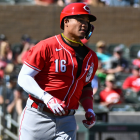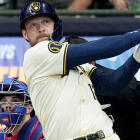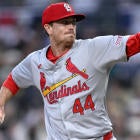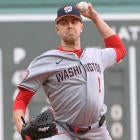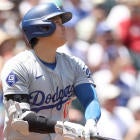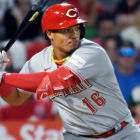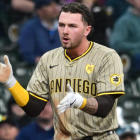To help you prepare for your Fantasy draft, our Scott White has constructed a list of five guidelines that often help him in his. He's released them in a series of columns called Draft Day Do's and Don'ts ( Part I / Part II / Part III / Part IV ). Consider incorporating them into your own draft strategy to get a leg up on the competition.
No. 5: Be flexible
Taking my cue from "The Bullwinkle Show," I could assign this section a second title -- something like, "The rules are made to be broken." But I don't like that second title. It's a bit cliche.
It's also not entirely accurate. I don't want to mislead anybody -- if you devise a strategy going into the draft, you need to stay the course and follow it to its completion, and I think the temptation to abandon ship when you get caught up in the draft's many nuances is far greater than the temptation to stick to the plan even though the circumstances that made it useful have changed.
But the latter can happen too. Sometimes, especially if you have the same stubborn streak that I do, you can follow a strategy so blindly that you bring about your own downfall. No matter what, you stick to a preset plan, etched in stone and preserved in marmalade, ignoring that, by doing so, you either dig yourself into a hole or back yourself into a corner.
Let me give you an example. Back in spring 2004, I liked Johan Santana -- which sounds ridiculous now because so does everyone else, but let me put it in historical context. Back then, Santana had just come off a career-high 18 starts. The Twins had mostly used him out of the bullpen in his career, and he had potential, but nobody knew exactly what he'd become. But I liked him enough that, after we had removed everyone's keepers from the player pool, I ranked him as my No. 1 starting pitcher going into the draft.
I also liked Aubrey Huff -- which sounds equally ridiculous, but, again, historical context. Huff had just come off a season in which he hit .311 with 34 home runs, giving him two straight with at least a .310 batting average. So yeah, I liked him, but not enough to rank him as my No. 1 outfielder.
So the third round came along, and a few starting pitchers had gone off the board -- none of them Santana. The choice seemed obvious, right? Take the guy I loved enough to rank disproportionately high to everyone else? But no, I took Huff, dead set on my premeditated plan of building a core offense before even bothering with pitching.
I did that -- in a keeper league, no less, one that awarded three points per inning pitched, making starting pitchers especially valuable -- and I've never forgiven myself for it. If I really had that strong a belief in Santana, why didn't I take him? Why oh why oh why?
I'll tell you why: I broke Draft Day Do and Don't No. 5. I wasn't flexible.
I came in hellbent on following that plan I devised in the weeks before, even when a more obvious solution slapped me so hard in the face I couldn't even see straight. And so as I come to you bringing all these rigid guidelines to follow, I need to attach a word of caution: Even if you subscribe to them, you might need to break them on occasion.
With all of these dos and don'ts, you need to remember that if everyone followed them to a tee, they'd no longer apply. If everyone in your league decided to forego an elite closer, ignore catchers in the middle rounds, and wait to take the last available second-tier second baseman, players' perceived values at those positions would drop to less than their actual values, and then a whole new set of dos and don'ts would apply. Either that or the draft would fall into a complete stalemate until someone had the courage to stand up and say, "I'm taking Brandon Phillips, dang it."
All those Fantasy-relevant low-strikeout starting pitchers -- the Roy Halladays, Joe Blantons and Mark Buehrles I told you to avoid in Dos and Don'ts No. 3 -- still have value, so if everyone avoided them, at some point, you couldn't. If you needed a No. 4 starting pitcher, for example, and Fausto Carmona somehow hadn't found a home yet, you'd take him -- and you should.
The point of the Draft Day Dos and Don'ts is to help you identify and exploit the typical Fantasy Baseball draft's inefficiencies. But if in the early stages of your draft, you get the impression that everyone else in your league recognizes one of those same inefficiencies, you might need to adjust your approach a bit.
Let me give you a football example. For years, Fantasy Football gurus tried to get everyone on board with taking running backs early. But every year in every league, some smart aleck thought he could win with quarterbacks and receivers, causing other owners to panic and take players at those positions too, causing one or two owners to rack up a stable core of running backs in each of the first four rounds and, quite often, win their leagues handily. But now that everyone has finally bought into the running back strategy, it's lost much of its relevance. When a league has 25 running backs going with the first 30 picks of its draft and Tatum Bell trickling off the board at the end of the third round, suddenly that one guy who grabbed Reggie Wayne and Chad Johnson in Rounds 2 and 3 doesn't look like such a dummy.
But you might have to adjust because of something more subtle. Say you had planned to grab an elite shortstop -- a Hanley Ramirez, Jose Reyes or Jimmy Rollins -- and missed out, and you see Russell Martin still available two or three rounds after Victor Martinez had gone off the board, I'd endorse that pick even though I normally wait until the last round or two to grab a catcher. Hey, you have to make up those lost points somewhere else on the diamond.
So I absolutely support an occasional departure from the preset plan. No, you don't want to get caught up in every whim of the draft, falling so far out of touch with your strategy that you end up having to take Jose Lopez as your starting second baseman. But you don't want to go into the draft so rigid and inflexible that you end up making foolish mistakes either. The draft room rewards owners who know how to adapt and adjust, so think on your feet. Don't go on autopilot. Otherwise, you might miss out on the next Johan Santana.
And with that, I've given you the basic framework of what I consider an effective Draft Day strategy -- or at least everything you need to know to undermine me in one of my leagues. Would I call my strategy perfect? No -- and I'll no doubt spend the rest of my Fantasy-playing existence fine-tuning each of my five major guidelines. Some apply better to some formats than others. Some require exceptions and qualifiers. All brought up questions from our readers, and I'll take a few moments to answer some of those questions now.
I'm having trouble coming up with tiers for each position (Part I). Could you please e-mail me a tier list at each position? I'd greatly appreciate it. Thanks. --Brian Sloan, Edison, N.J.
SW: No Brian, I won't e-mail you my tiers. I will, however, direct you to the March 5 entry of my blog. I've listed them there. (Hey, I want people to look at it.)
Couple of questions: In the closers section of Dos and Don'ts (Part II), into what tier would you put Todd Jones? I've seen him going very late in drafts, but he will start as Detroit's closer and get good chances to get at least 30 saves. Also, why would you not put Ryan Howard into Tier 1 with Albert Pujols and Prince Fielder (Part I)? -- Larry Asbury
SW: Two good questions deserve two good answers, Larry. I place Todd Jones (along with partner-in-crime Joe Borowski) in my last tier of closers, alongside Brandon Lyon, Eric Gagne and Troy Percival, among others. I just think Jones is a bad pitcher -- plain and simple. I know the Detroit closer should get ample save opportunities, but I'm not sure Jones will remain the Detroit closer. I think his potential for a blowup -- speaking on a season-wide level -- is too great. And I've heard the argument that Jones doesn't have anyone to replace him right now, but if he has an ERA over 6.00 and is blowing a save or two a week, you don't think the Tigers might try someone else? They don't look like they have an in-house replacement now, but good relievers emerge out of nowhere every year. Who was talking about Takashi Saito, J.J. Putz, Bobby Jenks, Manny Corpas or Joakim Soria for saves before they actually started getting them?
As for Howard, I don't trust his contact rate to produce a high batting average like I do Pujols' and Fielder's. Howard's mark dropped from .313 in 2006 to .268 last year, and I think he'll hit closer to the latter for most of his career. Plus, all his strikeouts kill you in leagues that count them. I rank Howard alongside Pujols and Fielder only in Head-to-Head points leagues that don't count strikeouts and do count walks, making OPS more important than batting average (and making strikeouts, of course, a non-issue).
I am really enjoying your Draft Day Dos and Don'ts. My question is how soon do you jump on Victor Martinez (Part II), seeing as he produces so much more than any other catcher, making him a tier all by himself? I am thinking of taking him with my second-round pick. Or would you be content taking Joe Mauer in a later round? -- Jesse Hailey, Pierre, S.D.
SW: Does Martinez really produce that much more than any other catcher? You wouldn't put Russell Martin at least in the same ballpark? I encourage you to make your own tiers, of course, but I group Martinez and Martin together in mine and wait until the fourth round or so to consider them. If I can't get one of them -- and I usually don't -- I just wait until the last round or two of the draft to pick through the leftovers. I do have one tier in between the two extremes that includes Mauer, Brian McCann and Jorge Posada, but they never go late enough for me to give them serious consideration.
Scott, I think you're a little off on the strikeout thing (Part III). First off, the older that sinkerballers get -- Chien-Ming Wang, Fausto Carmona, etc. -- the more strikeouts they get. Like Brandon Webb -- look at his strikeouts over the years. So watch: A guy like Wang might have 150-160 strikeouts this year. -- Evan Kolkos, New York
SW: I wouldn't normally reward a lack of research with a response, but I had more than one person write me trying to use Webb to discredit my strategy. So let me clear up the misconception now: Webb is a strikeout pitcher. He has always been a strikeout pitcher. For his career, he's averaged 7.3 strikeouts per nine innings, and he had his best strikeout rate as a rookie. Just because some of the best sinkerballers (Wang, Carmona and Derek Lowe) don't record strikeouts doesn't mean all don't. Notice I included Jason Bergmann among my sleepers for deeper leagues. He's a sinkerballer. If you want to follow my strategy of drafting pitchers for strikeouts, feel free to take Webb, but I maintain you should avoid Wang, Carmona and Lowe.
Don't forget about those of us in the really deep leagues. Rick Vandenhurk had 82 strikeouts in 81 2/3 innings last year, I believe. -- Ryan Watson
SW: Good catch, Ryan, and if VandenHurk works his way into the rotation, I'll definitely keep an eye on him on waivers. You can probably let him go undrafted, though -- even in NL-only leagues (assuming only 10-12 teams).
Interesting theory on drafting strikeouts, except you neglected a scenario that exists in my AL-only league. Would the same premise apply when strikeouts are not counted -- when it's only wins, ERA, WHIP and saves? Sounds like you're saying it does. -- Reid Creager
SW: That's exactly what I'm saying -- at least to an extent. If I played in a league where strikeouts had no value in their own right, I probably would acknowledge the value of Roy Halladay, Fausto Carmona and Chien-Ming Wang -- pitchers who have proven dominant in the past despite a lack of strikeouts -- and draft them about where everyone else ranks them. But in searching for breakouts among young pitchers, I'd look at strikeouts first -- or perhaps more accurately, strikeout-to-walk ratio -- followed by WHIP. I'd more or less ignore ERA and win-loss record.
I found your article regarding the philosophy of "chasing the strikeouts" very interesting, as I am always the guy chasing the Tim Wakefields and Jeff Suppans late in the draft. After reading your article, I am contemplating changing my ways. My question to you is this: How do you determine which pitchers "have the strikeouts" and which do not? What is your criteria? Where do you draw the line? -- Russ Bak, Plainfield, Ill.
SW: Unfortunately, it's not an exact science, Russ, and I more or less just go on feel. As a general rule, I like to use starting pitchers who strike out at least seven batters per nine innings, but I included Micah Owings, Jason Bergmann and Andy Sonnanstine on my list of sleepers, and they all struck out less than seven per nine. I guess if a young pitcher falls just short of the mark, I look at his game log, and if I find a handful of games where he struck out a batter per inning or more -- particularly later in the season -- then I think he has the potential to up those strikeouts just enough in the years ahead to qualify.
You can e-mail Scott your Fantasy Baseball questions to dmfantasybaseball@cbs.com. Be sure to put Attn: Draft Day in the subject field. Please include your full name, hometown and state.









